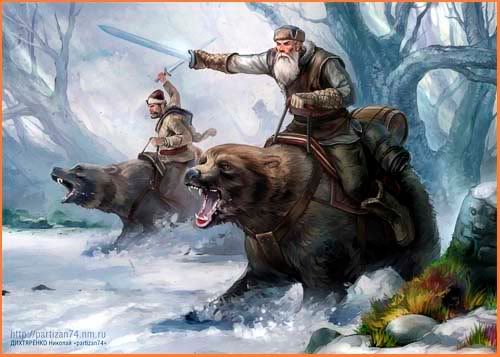 I've decided to call my strategy-RPG campaign "Green Pass", since that's the boundary feature between the Kingdom of Durnovar and the Undying Lands. I'm using the ACKS (Adventurer Conqueror King) ruleset to handle high-level features like economics, armies, and important leaders. For exploration-oriented play, I'm adding a number of new subsystems written for my Fantastic Frontiers project, to test them out. I'll just need to add a few mechanisms to link aspects of the exploration game to the kingdom-building game, and then everything should be fully integrated.
I've decided to call my strategy-RPG campaign "Green Pass", since that's the boundary feature between the Kingdom of Durnovar and the Undying Lands. I'm using the ACKS (Adventurer Conqueror King) ruleset to handle high-level features like economics, armies, and important leaders. For exploration-oriented play, I'm adding a number of new subsystems written for my Fantastic Frontiers project, to test them out. I'll just need to add a few mechanisms to link aspects of the exploration game to the kingdom-building game, and then everything should be fully integrated.The general concepts in this system should be pretty familiar to anyone who's played a normal RPG. The main difference here is that instead of controlling a single person, you're controlling an entire collection of leaders and all their possessions. Rob Kuntz (one of the original Lake Geneva GMs) calls this a "stable of player characters". In effect, you'll have a whole set of different alter egos that operate on multiple scales of gameplay, from neophyte heroes to high-ranking lords.
To join the campaign, it's necessary to create both a ruler and a realm. To provide an example for the benefit of anyone else who'd like to play, I'll do an example of the character/realm creation system for high-level play. This is using material from the last section of the ACKS rule book on starting a high-level campaign, as well as the draft of the soon-to-be-released Domains at War rules for military campaigns. The basic rules cover mostly conventional RPG play, but the newer releases cover strategic and tactical wargame play.
The ruler of your realm is your top-level player character, who will start with 310,000 experience points. This is enough to put most character classes in the vicinity of level 8-10, which is pretty powerful in a system where maximum level is 14. The default character creation method is 3d6 in order yielding modifiers limited to the +/- 3 range, which results in characters who have relatively few ability bonuses and force you to play with some unconventional stat combinations. It does allow rolling five different characters (to pick the one you like best), and it lets you roll a 7th "wild card" roll that can be swapped in to replace (for example) any horribly low stat that would otherwise ruin a character.
After rolling five characters, two of them look promising. One is a really good mage (INT 17 and CON 16, both +2 stats), with a wildcard of 14. I could use that to replace either DEX 8 (a -1 penalty) or CHA 11. Charisma is really important for a leader, so getting a bonus there is appealing. The other is a decent cleric (WIS 15, CHA 15, and CON 15, all +1 stats). To compare these options, let's look at the options they'd offer for realm-level play. I'll assume you're already familiar with how they work in man-to-man combat, based on some prior RPG experience.
Fighters (and fighter subclasses like paladins, etc)
These characters are built tough (in a game system that makes most characters very fragile and prone to death!) and they make excellent leaders on the battlefield commanding armies. ACKS has a generous rule for cleave/sweep attacks, so a fighter can do a tremendous amount of damage in massed combat if provided with adequate healing and potions.
- Best for: Building large armies and commanding them in the field
- Also good for: Economic play involving realm expansion
 These characters are the classic "mad scientists" of the fantasy world, building great laboratories and using them to collect monsters (and magically engineer freaky new ones). They can mass-produce magical items for use by army leaders, develop powerful new ritual spells that can turn the tide of a battle, and deploy constructs like golems and bizarre hybrids (think: this). They play a support role in realm-building, in some sense, but a very potent one.
These characters are the classic "mad scientists" of the fantasy world, building great laboratories and using them to collect monsters (and magically engineer freaky new ones). They can mass-produce magical items for use by army leaders, develop powerful new ritual spells that can turn the tide of a battle, and deploy constructs like golems and bizarre hybrids (think: this). They play a support role in realm-building, in some sense, but a very potent one.- Best for: Crafting items, new monsters, and powerful spell rituals
- Also good for: Economic play (especially when chaotic-aligned, since many monsters are chaotic)
 Priestly characters rule as a convenient combination of fighters and mages. They are very good at the administration of large realms, and can also draw on the devotion of their followers to create magical items, though not on quite the same scale of production as mages. They also have ritual spells, but only up to 7th level, not 9th. Unlike mages, they don't naturally attract monsters, and they can't create constructs or design hybrids.
Priestly characters rule as a convenient combination of fighters and mages. They are very good at the administration of large realms, and can also draw on the devotion of their followers to create magical items, though not on quite the same scale of production as mages. They also have ritual spells, but only up to 7th level, not 9th. Unlike mages, they don't naturally attract monsters, and they can't create constructs or design hybrids.- Best for: Growing a large, prosperous realm
- Also good for: Crafting a few powerful items
 Unlike the other three classes, rogues don't rule populations at all. Instead, they form criminal guilds that function as a multipurpose criminal element, infiltrating everyone else's realms. Rather than having a large number of 0th-level soldiers, they have a small number of higher-leveled characters who can be assigned to various covert activities like assassination, burglary, treasure-hunting, and information-gathering. They can also earn a living by functioning as honest traders, but that's not as much fun. These underlings tend to level up quickly, letting a rogue effectively control a large number of lower-level player characters. If they can elude the law, that is.
Unlike the other three classes, rogues don't rule populations at all. Instead, they form criminal guilds that function as a multipurpose criminal element, infiltrating everyone else's realms. Rather than having a large number of 0th-level soldiers, they have a small number of higher-leveled characters who can be assigned to various covert activities like assassination, burglary, treasure-hunting, and information-gathering. They can also earn a living by functioning as honest traders, but that's not as much fun. These underlings tend to level up quickly, letting a rogue effectively control a large number of lower-level player characters. If they can elude the law, that is.- Best for: Causing mischief and mayhem
- Also good for: Causing more mayhem, for profit
With that in mind, I'll actually pick the cleric character, since that gives me a chance to show off a balanced style of development focused on realm-building. With 310,000 exp, a cleric can start at 10th level. This provides access to all five normal spell levels of divine casting, although it will take one more level to unlock ritual spells.
Each starting ruler get a 240,000 gold piece budget to develop a realm. This realm-creation budget can be spent in the following areas:
- Purchasing a collection of normal equipment, which can be basic stuff like weapons and armor, but also entire caravans of wagons, or fleets of ships, to send off on trade missions.
- Purchasing magical items, or alternatively, the formulas to make new magical items in a workshop. You can either spend 100,000 to have a guaranteed set of lots of diverse magical gear (enough to equip you and a few henchmen), or spent lesser amounts to roll randomly a certain number of times on the treasure table. I opted to spent about 40,000 gp and roll randomly!
- Recruiting mercenaries (for an army), high-level henchmen (to lead your army or help you go adventuring), and various other support hirelings. Henchmen can eventually become alternate characters with their own domains in your realm ("vassals"), allowing you to get wildly rich in the classical medieval pyramid scheme.
- Building a stronghold (keep, castle, tower, wizard's sanctum, etc), and controlling an area of land ranging between 1 and 16 hexes, depending on the size of your stronghold. This land will automatically be populated with peasant immigrants, and you can invest money to further develop it and attract a larger population.
Since this post is running a bit long, I'll put the detailed breakdown of expenses in a following post.

No comments:
Post a Comment